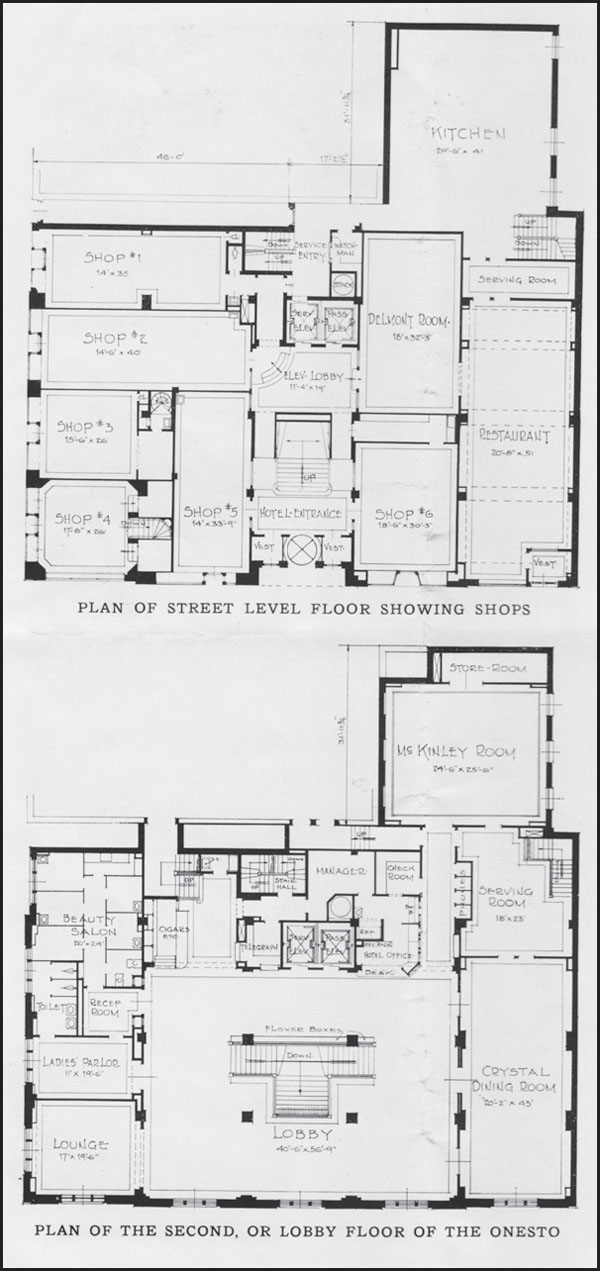Five
HOTELS

Francis A. Onesto opened the Onesto Hotel, located on the corner of Second Street NW and Cleveland Avenue, in 1930. It featured all the amenities of the modern age—high-speed elevators, hand-type telephones in every room, and an array of shops and services on the ground floor. Today, it is being converted into luxury apartments.

The Onesto Lobby was described in a promotional brochure as “beautifully decorated and splendidly furnished” in the Italian Renaissance style. With travertine terrazzo and walnut trim, it rivaled any hotel lobby to be found in a city much larger than Canton. The hotel also advertised a barbershop, coffee shop, and a ladies’ lounge.

The McKinley Room at the Onesto featured several large paintings by artist William Findley depicting events in President McKinley’s life. Today, two of those paintings are part of the permanent collection of the McKinley Presidential Library & Museum and are on loan to the Stark County Courthouse. The McKinley Room was used for private dining, wedding receptions, banquets, and dances.

The Onesto boasted 200 guest rooms. Single rooms with twin beds were described as “comfortable and well ventilated.” Amenities included a tiled bathtub or shower, circulating ice water, oscillating fans, an RCA radio, and a Simmons Beauty Rest mattress in each room. A room like this would have cost between $3 and $3.50 per night when the hotel first opened.

This floor plan for the Onesto Hotel shows the second floor, where the hotel lobby was located, and the first floor, which featured retail spaces for six shops and a restaurant. The lobby level was also the location of the front desk, telegraph office, beauty shop, ladies’ parlor, and the Crystal Dining Room.

The Town Shop was one of the stores located on the street level of the Onesto. It was owned by Maurice Rapport, a Russian immigrant who owned a chain of women’s clothing stores in Western Pennsylvania and Northeast Ohio. He also owned a shop called Rapport’s. Based on the clothing worn by the mannequins in the window, this photograph of the Town Shop is from the 1940s.

Advertised as “one of America’s most modern and best equipped hotels,” the Onesto had a private Checker Cabs stand for the convenience of its guests. It cost 25¢ for two passengers to ride a four-door sedan, with an additional 10¢ charge for each passenger after that. Guests could dial the stand from their rooms and take advantage of the company’s baggage service. (Courtesy of Jerry Novak.)

In 1905, architect Guy Tilden designed the Courtland Hotel at 209 West Tuscarawas Street, next to the Stark County Courthouse. It featured 150 rooms and was considered “the headquarters of the traveling public” in a 1922 booklet about Canton published by Herman R. Witter. The hotel featured a reading room, a telephone exchange in the lobby, and hot and cold water in each room.

The hotel’s proprietor, W.S. Langford, described the Courtland Hotel’s dining room as “the most beautifully decorated and arranged of any such room to be found.” A 1912 menu listed codfish and cream on toast, calf’s liver with bacon, and imported frankfurters with horseradish among the evening entrees. Many important gatherings took place in the dining room, including the meeting to organize the National League of Professional Football Clubs in 1921.

The Courtland was renovated and renamed the St. Francis in the 1940s but soon fell on hard times. In 1960, the county purchased the building and turned the former grand hotel into office space. In 1985, Repository reporter Louise Johnson described the structure as “an aging queen with her crown askew and a rip in her dress.” Today, all that remains of the Courtland Hotel is the archway of the front entrance, just west of the Stark County Courthouse on West Tuscarawas Street. This photograph was taken in 1955 during Canton’s sesquicentennial celebration.

The McKinley Hotel opened in 1901 at the corner of South Market Avenue and Third Street (which was known as Eighth Street until the downtown streets were renumbered in 1913). Its location near the Grand and Lyceum Theatres made it an ideal stopover for traveling performers such as Al Jolson, Elizabeth Risdon, and Rudolph Valentino. Pres. Teddy Roosevelt also stayed there while in town for a celebration honoring Pres. William McKinley in 1903. The hotel fell into disrepair and was razed in 1972 to make room for more downtown parking. In its last days, it served as a home for more than 100 residents, most of whom were senior citizens. (Courtesy of Dawn Walter.)

The Barnett Hotel was built in the 1880s and quickly became a fashionable place to live as well as a popular spot for banquets. An 1892 advertisement in the Repository read, “The Barnett has been remodeled and refurnished new throughout. Strictly first-class in all its appointments. Electric bells, electric light and heated by steam. Streetcars pass the doors to all depots. Centrally located, and has the finest sample rooms of any hotel in the city. Rates $2.00 to $2.50 per day.” An 1897 menu offered baked blue fish, prime roast of beef au jus, fresh lobsters a la Newburg, and small oyster patties. The Barnett became the Milner in the 1930s and the Drake in 1959. A fire destroyed the hotel in May 1960.

Hotel Belden was located at Sixth Street and North Market Avenue. The Knights of Pythias opened the hotel in 1921 under the name the Northern. It featured “circulating drinking water” and “shower and tub baths” in all of its 110 rooms, according to an advertisement in the Canton Daily News. It became the Belden in 1935 when Paul B. Belden purchased it. The hotel’s restaurant was called the Purple Cow, which was remembered as the “last stopping point” for GIs heading off to fight in World War II. In the 1960s, Ray Buttermore played the organ every night in the hotel’s Viking Room. The building was razed in July 1978.












